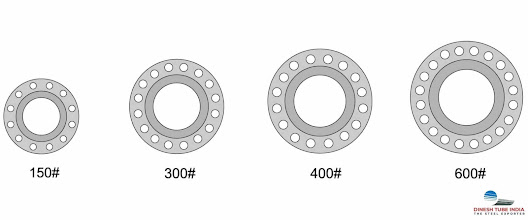Carbon Steel Flanges VS Stainless Steel Flanges
Generally speaking, a flange is
a forged or cast ring of steel that is used to connect or join sections of
pipe. It also includes flanges that are integral to pressure vessels, pumps, or
any other element that utilizes flanges. Bolts connect flanges together and
threaded or welded them to the piping system. There are a variety of types of
flanges available, including stainless steel flanges (SS flanges), alloy steel
flanges, carbon steel flanges, slip-on flanges, blind flanges, weld neck
flanges, threaded flanges, lap joints, and orifice flanges. This article
discusses stainless steel vs carbon steel.
What are
carbon steel flanges?
A flange connects two ends of a pipe or ends a
pipe. Various materials are available for them. Flanges made from carbon steel
are one such type. This material provides excellent durability, corrosion
resistance, and finishing properties. There are several types of them. It is
common to use Carbon Steel Blind Flanges to terminate pipes. The raw materials
used in the manufacture of these flanges are of high quality. Between 0.25 and
0.60 percent of their carbon content is carbon. In addition to being highly
ductile, the product is also excellently fabricated due to its high carbon and
manganese content.
What are
Stainless steel flanges?
In residential, commercial, and industrial
piping systems, stainless steel flanges and fittings are used. Stainless steel
is widely used for the transportation of gases or liquids, chemical processing,
maritime applications, sanitary applications, and areas requiring corrosion
resistance because of its strength, corrosion resistance, and ability to
withstand high temperatures, pressures, and flows.
To
determine the right stainless steel grade and flange type for your application,
refer to the appropriate standards or contact us. To determine the right
stainless steel grade and flange type for your application, refer to the
appropriate standards or contact us.
Carbon Steel
vs Stainless Steel
Stainless steel has a higher melting point and
a lower carbon content than iron-carbon alloys. In appearance and properties,
carbon steel is similar to stainless steel, but it contains a higher percentage
of carbon.
A common application of engineering and
construction materials like carbon steel is in large-scale industrial processes
like telecommunications, transportation, chemical processing, and petroleum
extraction and refining.
The process used in making Stainless Steel 304
Flanges is essentially two steps consisting mostly of iron and carbon. There
are many types of steel that can be called stainless steel 304 flanges.
Corrosion resistance can be achieved by adding nickel and chromium to stainless
steel.
Flanges in
detail:
Pipe Flanges are most often manufactured from
forgings produced in grades A-105. There are two grades of A-350 material: LF2
for applications requiring lower temperatures and F42-F70 for applications
requiring high yields. It is widely accepted that pipeline service is carried
out with high-yield materials due to their increased strength.
Besides having a greater amount of chrome and
molybdenum than carbon steel flanges, alloy steel flanges are able to withstand
temperatures and pressures that are higher than those of carbon steel flanges.
In contrast to conventional carbon steel flanges, they have a higher Chromium
content, which makes them more corrosion resistant.
Flanges are commonly manufactured from
stainless steel containing Nickel, Chromium, and Molybdenum. Flanges are
commonly manufactured from stainless steel containing Nickel, Chromium, and
Molybdenum. Forgings classes can be serviced with trace elements during
melting. Aside from this, the 300 Series is not magnetic, whereas the 400
Series is magnetic, as well as has weakened corrosion resistance.
Read More About This Article
On Our Website For More information: https://thesteelexporter.com/carbon-steel-flanges-vs-stainless-steel-flanges/
#design #architecture #interiordesign #steel #art #garden #gardendesign #rust #gardening #sculpture #metal #welding




Comments
Post a Comment